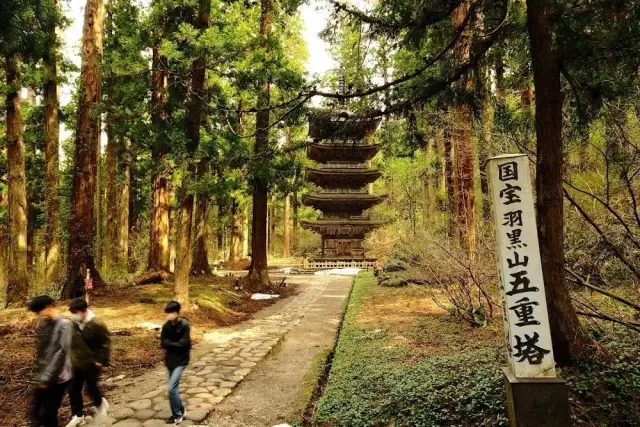https://www.dekitabi.com/itinerary/tsuruoka-day-trip-mount-haguro
Nestled in the picturesque region of Yamagata Prefecture, Japan, the Dewa Sanzan mountains are a revered destination for pilgrims and travelers alike. These sacred mountains—Mt. Haguro, Mt. Gassan, and Mt. Yudono—offer a profound journey into the heart of Japanese spirituality, culture, and history. Among these, Mt. Haguro stands out with its rich tapestry of cultural landmarks including Arasakuji Temple, the iconic Five-Storied Pagoda, and the enlightening Ideha Cultural Memorial Museum.
Mt. Haguro: A Spiritual Ascent

https://www.dekitabi.com/attraction/kotaku-ji-
Mt. Haguro (羽黒山) is the lowest of the three sacred mountains of Dewa Sanzan but holds immense spiritual significance. It is the only one of the three mountains accessible all year round, making it a popular pilgrimage site. The ascent to the summit is an experience like no other, starting from the grand Zuishinmon Gate, which marks the entrance to the sacred area.
The path to the top is a 2,446-step stone staircase, flanked by ancient cedar trees, some over a thousand years old. This mystical forest, known as the Suginami (杉並), envelops visitors in a serene ambiance, offering a peaceful escape from the hustle and bustle of modern life. As you climb, the scent of cedar and the sound of rustling leaves enhance the meditative experience, preparing your mind and soul for the spiritual treasures awaiting at the summit.
Arasakuji Temple: A Historical Sanctuary

https://www.dekitabi.com/attraction/dewasanzan-jinja-shrine
At the heart of Mt. Haguro lies Arasakuji Temple (荒削寺), a testament to the mountain’s deep spiritual roots. This temple, dedicated to the mountain’s protective deities, has been a center of Shugendo practice for centuries. Shugendo, a syncretic religion blending elements of Shinto and Buddhism, emphasizes ascetic practices and communion with nature, and Mt. Haguro is one of its most important sites.
Arasakuji Temple offers a glimpse into this unique spiritual tradition. The temple grounds are adorned with statues of Yamabushi (mountain ascetics), who traditionally train in these mountains. Visitors can explore the temple’s intricate architecture, which reflects the blending of Buddhist and Shinto styles. The serene atmosphere, coupled with the temple’s historical significance, provides a profound sense of connection to Japan’s spiritual heritage.
The Five-Storied Pagoda: A Symbol of Harmony

https://www.dekitabi.com/attraction/hagurosan-gojunoto
One of Mt. Haguro’s most iconic landmarks is the Five-Storied Pagoda (五重塔). This pagoda, designated a national treasure, stands as a symbol of harmony and resilience. Constructed over 600 years ago, it is one of the oldest and most beautiful wooden pagodas in Japan.
The pagoda’s architectural elegance lies in its simplicity and symmetry. Each of its five stories represents one of the five elements in Buddhist cosmology—earth, water, fire, wind, and void. This symbolic representation of the universe’s harmony is a central theme in Buddhist philosophy. The pagoda’s wooden structure, built without nails, showcases the ingenuity of ancient Japanese craftsmanship.
Surrounded by towering cedar trees, the Five-Storied Pagoda creates a mesmerizing sight, especially when shrouded in mist. The pagoda’s peaceful presence invites contemplation and reverence, making it a must-visit for those seeking to experience the spiritual essence of Mt. Haguro.
Ideha Cultural Memorial Museum: A Journey Through History

https://www.dekitabi.com/attraction/ideha-bunka-museum
To delve deeper into the rich history and cultural significance of Dewa Sanzan, a visit to the Ideha Cultural Memorial Museum (出羽三山歴史博物館) is essential. Located at the base of Mt. Haguro, this museum offers comprehensive insights into the region’s spiritual heritage, natural environment, and the Shugendo tradition.
The museum’s exhibits include a fascinating array of artifacts, from ancient religious texts and ceremonial objects to traditional Yamabushi attire and tools. Through these exhibits, visitors can gain a deeper understanding of the ascetic practices and rituals that have been performed on these mountains for centuries. Interactive displays and detailed explanations make the museum an engaging educational experience for all ages.
One of the museum’s highlights is the replica of the Five-Storied Pagoda, allowing visitors to appreciate the architectural details up close. Additionally, the museum provides information on the flora and fauna of the Dewa Sanzan area, highlighting the deep connection between nature and spirituality in Shugendo practices.
Experiencing Dewa Sanzan: Tips for Travelers
When planning your visit to Dewa Sanzan, there are a few key points to consider to make the most of your journey:
- Best Time to Visit: While Mt. Haguro is accessible year-round, the best times to visit are spring and autumn. In spring, the mountain is adorned with cherry blossoms, creating a breathtaking sight. Autumn, on the other hand, transforms the area into a vibrant tapestry of red, orange, and yellow leaves.
- Proper Attire: As you will be climbing a significant number of steps and traversing forest paths, comfortable walking shoes are essential. Dressing in layers is advisable, as the weather can change rapidly, especially at higher altitudes.
- Cultural Respect: When visiting sacred sites such as Arasakuji Temple and the Five-Storied Pagoda, it’s important to be respectful. Observe local customs, such as bowing at the temple gates, and refrain from loud conversations.
- Guided Tours: For a more enriching experience, consider joining a guided tour. Knowledgeable guides can provide deeper insights into the historical and spiritual significance of the sites, enhancing your understanding and appreciation.
Conclusion
Mt. Haguro, with its sacred temples, awe-inspiring pagoda, and enriching museum, offers a unique glimpse into Japan’s spiritual and cultural heritage. A journey to this mystical mountain is not just a physical ascent but a profound exploration of the soul. Whether you are a spiritual seeker, a history enthusiast, or simply a traveler looking to experience Japan’s natural beauty, Mt. Haguro and its treasures await you with open arms.
By embracing the serene beauty and spiritual depth of Mt. Haguro, visitors can find a renewed sense of peace and connection, making it a truly transformative destination. As you explore the wonders of Arasakuji Temple, the Five-Storied Pagoda, and the Ideha Cultural Memorial Museum, you will uncover the timeless traditions and enduring spirit of Dewa Sanzan, leaving you with memories that will last a lifetime.


Leave a Reply